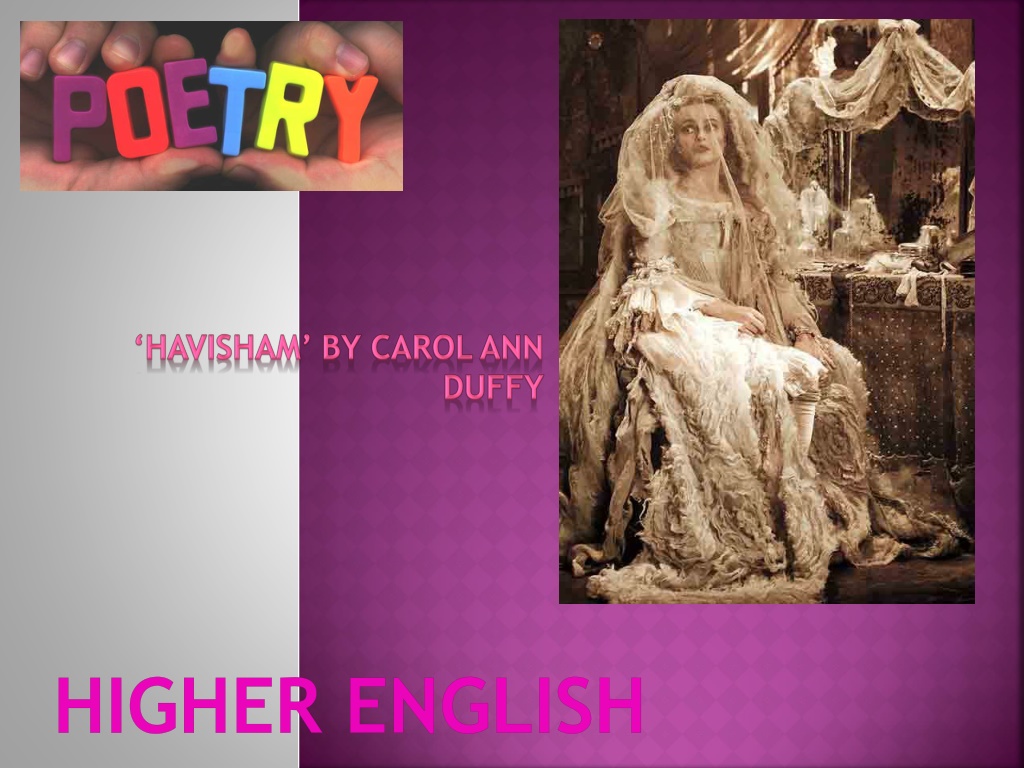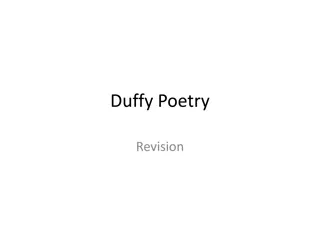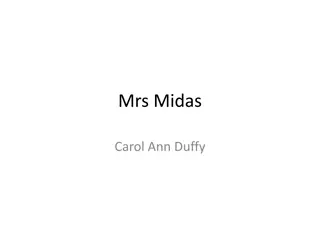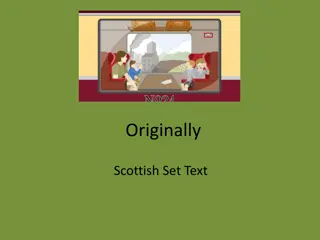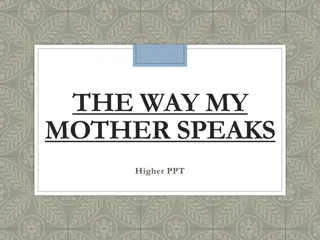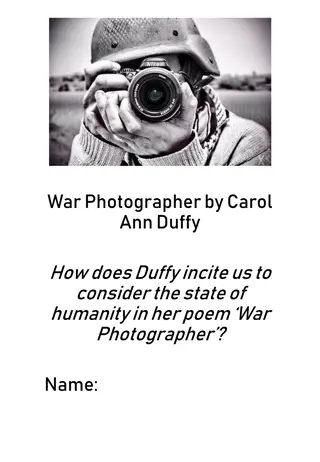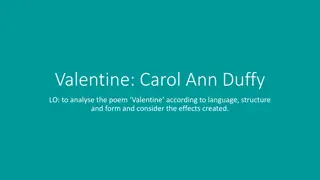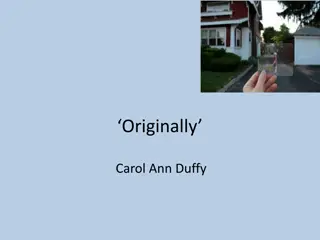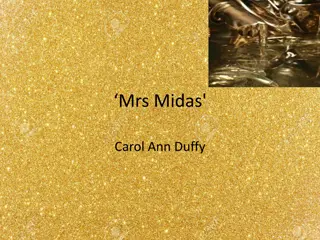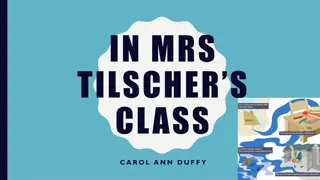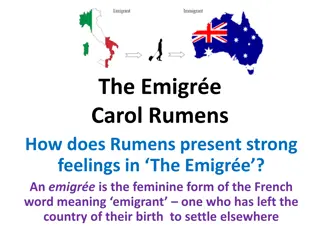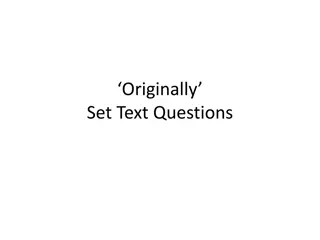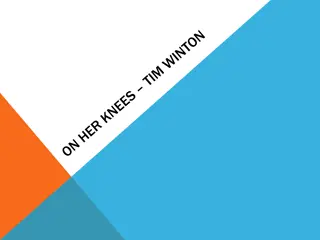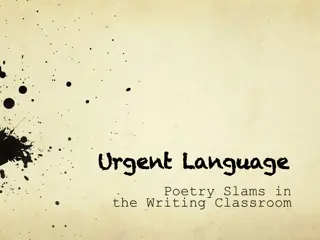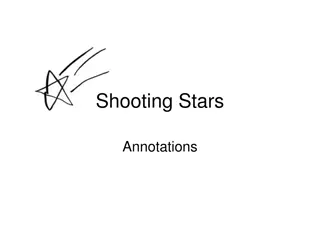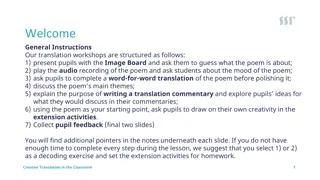Exploring Carol Ann Duffy's Poem "Havisham
Dive into the analysis of the Carol Ann Duffy poem "Havisham" in these lessons. Discover the use of monologue, themes discussed, and poetic techniques. Explore the background of the character Miss Havisham from Charles Dickens' novel, and unravel the emotions and story behind the poem. Learn how to interpret poetry using the SPIRIT technique for a deeper understanding of the text.
Download Presentation

Please find below an Image/Link to download the presentation.
The content on the website is provided AS IS for your information and personal use only. It may not be sold, licensed, or shared on other websites without obtaining consent from the author. Download presentation by click this link. If you encounter any issues during the download, it is possible that the publisher has removed the file from their server.
E N D
Presentation Transcript
LEARNING INTENTIONS In this series of lessons, we will: Study the Carol Ann Duffy poem Havisham . Consider the use of monologue to reveal the character Think about the themes explored in the text Identify and explain poetic techniques
CAROL ANN DUFFY Carol Ann Duffy (born 1955) is a Scottish poet, and is currently the UK s first female (and first Scottish!) Poet Laureate She wrote poetry from an early age, and was first published at the age of 15. She has since written plays, critical works, and several volumes of poetry. Duffy often tackles difficult subjects, encouraging the reader to explore alternative points of view. Duffy s poetry is often feminist in its themes and approach.
HAVISHAM BACKGROUND The speaker in the poem is the character of Miss Havisham, taken from the Dickens novel Great Expectations . In the novel, she is deserted at the altar on her wedding day by her husband-to-be. She is completely devastated and never recovers. She continues to wear her decaying wedding dress, adopts a daughter and brings her up teaching her to hate all men. https://www.youtube.com/watch?v=WjadQG- soNo
HAVISHAM THE POEM The poem is written in the form of a monologue The poem provides another insight into Miss Havisham, which gives the reader some empathy into her situation. It is also about obsessive love gone wrong.
HAVISHAM THE POEM Havisham is Miss Havisham s story in her own words. She reflects on her feelings for the man who left her, and the effect it has had on her. It explores how she could have come to be the woman she is. She remembers her ex in her dreams and feels better, until she wakes herself up trying to bite him. There is a sexual element to the dreams, and this is carried on into the violent end of the poem that wants him dead.
GETTING INTO THE SPIRIT OF POETRY The SPIRIT technique gives you a quick way to crack open a poem, pull it apart and explore the main ideas and themes. It features six areas of analysis. Copy this table into your jotter to refer to later.
THATS THE SPIRIT! Considering the 6 elements of Spirit, what do you think you would look for within each one? Why do you think each is important?
STRUCTURE (AND FORM) Title why do you think the poem is called Havisham ? (Don t just think about the obvious! What is missing from the title? Why is it missing?)
THE TITLE The poem is entitled simply Havisham and deliberately omits her personal title of Miss. This could be because it is too painful for her to be reminded of the fact she is unmarried. It could be suggested that she is caught between the states of being married and single, and thus there is no title for her. Havisham was her maiden name, and therefore by having this by itself it still stresses the fact she is unmarried while also sounding harsh when said aloud (not softened by having Miss in front) It can also be suggested that it is a deliberate act by the poet herself to differentiate this view of the character from the well-known version written by Dickens.
STRUCTURE (AND FORM) Havisham is a dramatic monologue [dramatic monologue: A poem in which the speaker addresses the reader directly. A dramatic monologue usually involves a fictional speaker who may not necessarily speak the views of the poet.] Havisham is written in the first person, with the poet assuming the voice of a character. This form enables us to better understand the character s thoughts because she is speaking them directly. There is no sense of an audience, so she appears to be speaking to herself.
STRUCTURE (AND FORM) The poem is written in free verse [free verse: A style of poetry that contains lines and verses of varying lengths and composition, usually without consistent rhyme patterns.] It has no regular pattern of metre or rhyme. It is, however, arranged in four stanzas of equal length, which suggests some control in its speaker, undermining the madness the character is known for, which is one of the points of the poem.
POETIC TECHNIQUES & IMAGERY We will now look at the stanzas of the poem, analysing the poet s use of imagery and the various poetic techniques, considering the effect created by each.
VERSE 1 What does the oxymoron in line one reveal about her feelings? Explain the image dark green pebbles for eyes. Explain the image ropes on the back of my hands.
VERSE 1 Beloved sweetheart bastard The poem begins as if addressed to the jilting bridegroom. It doesn't continue in this direct address - by the end of the poem the male figure will have become a male corpse - any male (generalised). The most striking thing about the first sentence is the combination of 'love' (beloved sweetheart) and hatred (bastard). Duffy is interested in the unstable combination of desire and hatred.
Highlights the intensity of her vengeful desires. VERSE 1 Oxymoron emphasises her contradictory feelingsHeavy emphasis here perhaps indicating her negative/aggressive feelings are now the dominant ones. Beloved sweetheart bastard. Not a day since then I haven t wished him dead. Prayed for it so hard I ve dark green pebbles for eyes, ropes on the back of my hands I could strangle with. Hardened emotions? Dark for her evil thoughts of revenge. Green link with jealousy? Lack of transparency might highlight the way she conceals her true feelings. Accentuated veins - due to age, stress, murderous anger etc. Irony we usually pray for something good.
VERSE 2 Comment on the sentence structure of the first line. What is her attitude to the fact she is unmarried? Comment on the use of the word stink . Comment on the use of the word cawing . Comment on the last line can you explain the structure?
VERSE 2 Negative connotations Emphasises primitive rawness of emotions Placed at start of stanza, one word sentence, bitter tone. Literally true? Or low self esteem? Doesn t recognise herself profoundly changed by rejection. Spinster. I stink and remember. Whole days in bed cawing Nooooo at the wall; the dress yellowing, trembling if I open the wardrobe; the slewed mirror, full-length, her, myself, who did this Ambiguous her or the dress? Perhaps she is frightened of looking in the mirror and seeing what she has become. Avian terminology used to show how she feels demeaned or rejected by her lover who has flown the nest? Neologism: Repetition emphasises intensity of anguish Emphasises her isolation.
VERSE 3 What connotations are there for puce (dark purple/red)? What is the speaker describing in lines 10-13? What might this reveal?
Deep red connotations of puce? Dried blood? Disease? VERSE 3 Enjambment to convey the idea of run away emotions and a lack of control? To evoke a troubled, restless mind? to me? Puce curses that are sounds not words. Some nights better, the lost body over me, my fluent tongue in its mouth in its ear then down till I suddenly bite awake. Love s Sexual fantasy/dream reveals she cannot rid herself of her desire/affection which now torments her in the living nightmare of her waking existence. When she wakes the hatred and anger return
VERSE 4 What could the red balloon symbolise and what is the significance of it bursting? Comment on the use of onomatopoeia. What is the tone of this verse? Comment on the use of repetition in the final line.
VERSE 4 Shows how fragile love can be. Alliteration . Might symbolise her broken heart, her life destroyed abruptly? hate behind a white veil; a red balloon bursting in my face. Bang. I stabbed at a wedding-cake. Give me a male corpse for a long slow honeymoon. Don t think it s only the heart that b-b-b-breaks. One word sentence/ono matopoeia emphasises power/sudden ness of above. Repetition highlights her emotional and psychological fragility. As well as her heart, her mind is now broken. Command. A morbid, macabre, erotic perverse request. Deeply disturbed, vengeful and malevolent. Long + slow combination of enjoyment and torture
RHYTHM & RHYME In the style of free verse, there is no set pattern of rhyme or rhythm in the poem The only rhyme is between lines 14 and 16 at the end of the poem. Why do you think this is?
IDEAS / THEMES The poet is effectively exploring a number of themes in this poem. What might they be?
IDEAS / THEMES Damage that can be done by insensitive males/partners. Relationships the thin line between love and hate. How one event can profoundly affect a life. How some people never recover from personal trauma. How social convention/prejudice can cause unhappiness.
QUESTIONS Why does the poet omit Miss Havisham's title and refer to her by her surname only? Why does the poet write spinster on its own? What does Miss Havisham think about this word and its relevance to her? What is the effect of Nooooo and b-b-breaks ? Why are these words written in this way? How far does the poet want us to sympathize with Miss Havisham? Does the reader have to know about Great Expectations to understand the poem? Does Miss Havisham have a fair view of men? What do you think of her view of being an unmarried woman? Perhaps the most important part of the poem is the question who did this/to me? How far does the poem show that Miss Havisham is responsible for her own misery, and how far does it support her feelings of self-pity and her desire for revenge?
FINAL THOUGHTS Perhaps Miss defines the character socially - whereas the poem concentrates on the nature of the character's individual feelings - the character's psychological/sexual nature, rather than her social being. The lack of miss makes her seem less of a woman. However, Duffy wants to examine the sexuality of Miss Havisham and explore the sheer amount of pain the character has suffered. This is why Duffy chooses to write the poem in the first person.
